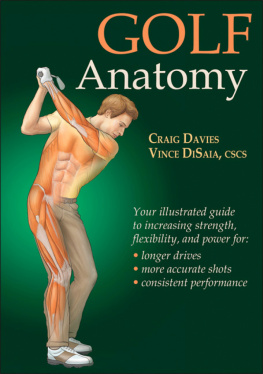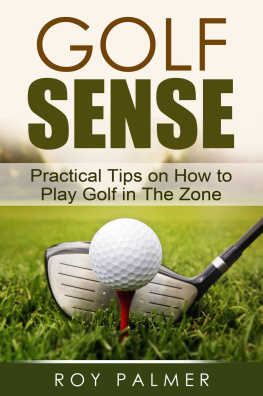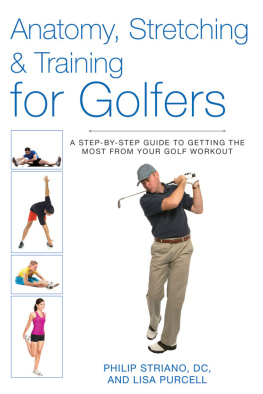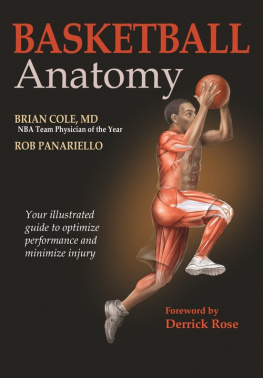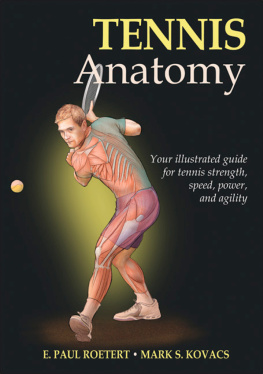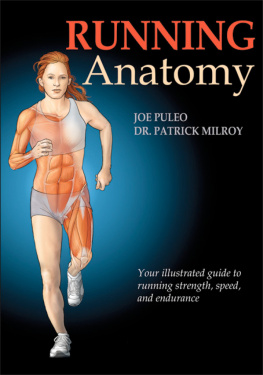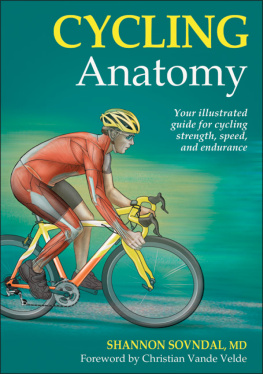GOLF ANATOMY
Craig Davies
Vince DiSaia,CSCS
Human Kinetics
Library of Congress Cataloging-in-Publication Data
Davies, Craig.
Golf anatomy / Craig Davies, Vince DiSaia.
p. cm.
ISBN-13: 978-0-7360-8434-5 (soft cover)
ISBN-10: 0-7360-8434-7 (soft cover)
1. Golf--Training. 2. Golf--Physiological aspects. 3. Biomechanics. I. DiSaia, Vince. II. Title.
GV979.T68.D38 2010
796.352--dc22
2009054271
ISBN-10: 0-7360-8434-7 (print)
ISBN-13: 978-0-7360-8434-5 (print)
Copyright 2010 by Craig Davies and Vince DiSaia
All rights reserved. Except for use in a review, the reproduction or utilization of this work in any form or by any electronic, mechanical, or other means, now known or hereafter invented, including xerography, photocopying, and recording, and in any information storage and retrieval system, is forbidden without the written permission of the publisher.
This publication is written and published to provide accurate and authoritative information relevant to the subject matter presented. It is published and sold with the understanding that the author and publisher are not engaged in rendering legal, medical, or other professional services by reason of their authorship or publication of this work. If medical or other expert assistance is required, the services of a competent professional person should be sought.
Acquisitions Editor: Tom Heine; Developmental Editors: Amanda Eastin-Allen, Cynthia McEntire; Assistant Editor: Laura Podeschi; Copyeditor: Patricia MacDonald; Graphic Designer: Fred Starbird; Graphic Artist: Francine Hamerski; Cover Designer: Keith Blomberg; Photographer (for illustration references): Neil Bernstein; Visual Production Assistant: Joyce Brumfield; Art Manager: Kelly Hendren; Associate Art Manager: Alan L. Wilborn; Illustrator (cover): Jennifer Gibas; Illustrators (interior): Dragonfly Media Group, Precision Graphics, and Jennifer Gibas; Printer: Versa Press
Human Kinetics books are available at special discounts for bulk purchase. Special editions or book excerpts can also be created to specification. For details, contact the Special Sales Manager at Human Kinetics.
Printed in the United States of America 10 9 8 7 6 5 4
The paper in this book is certified under a sustainable forestry program.
Human Kinetics Web site: www.HumanKinetics.com
United States: Human Kinetics
P.O. Box 5076
Champaign, IL 61825-5076
800-747-4457
e-mail: humank@hkusa.com
Canada: Human Kinetics
475 Devonshire Road Unit 100
Windsor, ON N8Y 2L5
800-465-7301 (in Canada only)
e-mail: info@hkcanada.com
Europe: Human Kinetics
107 Bradford Road
Stanningley
Leeds LS28 6AT, United Kingdom
+44 (0) 113 255 5665
e-mail: hk@hkeurope.com
Australia: Human Kinetics
57A Price Avenue
Lower Mitcham, South Australia 5062
08 8372 0999
e-mail: info@hkaustralia.com
New Zealand: Human Kinetics
P.O. Box 80
Torrens Park, South Australia 5062
0800 222 062
e-mail: info@hknewzealand.com
Converted to eBook by EasyEPUB
Foreword
P laying against the worlds best golfers on the PGA Tour requires extreme mental and physical conditioning. During the 2009 season, my conditioning allowed me to make the cut in 24 out of 25 tournaments, finish 16th on the PGA Tours money list, and represent my country on the victorious U.S. Presidents Cup team. To achieve these results and this level of consistency requires that every aspect of my golf game run on all cylinders.
The most notable change that has occurred in professional golf in the past decade is the necessity for players to maximize their physical skill sets. The fitness trailer that travels with the PGA Tour is busier every year as players attempt to maintain or gain an edge over their peers. Since starting to work with my good friend, Dr. Craig Davies, a few years ago, I have paid more attention to the fitness, nutrition, and physical side of my game. During tournament weeks, I make sure to warm up effectively for about 30 minutes prior to both my tournament rounds and pretournament practice sessions. I also make sure to spend the appropriate amount of time each day when I have finished play on my fitness regime and preventive physical therapy. My weekly program during the season is as much about increasing my performance as preventing injuries. As we all know, golf is a repetitive and stressful sport that can create a great deal of wear and tear on the body if you do not take care of yourself properly. Whether you are talking about professionals or weekend amateurs, it is not uncommon for at least one of the players in a foursome to use pain relievers to help him through a round. If you take care of your body, you should not have to rely on pain relievers.
While it is important to focus on golf fitness during the season, the off-season is when I have the chance to really make major changes to my physical skill sets. I think this is an important concept for both the amateur and professional player, especially those who live in colder climates and are not able to play golf during the winter. The off-season is the perfect time to really focus on your golf fitness and make changes to your body that will help develop your game in both the short and long term.
Golf Anatomy does a great job breaking down the various skill sets (balance, mobility, stability, strength, and power) and injury prevention exercises into simple-to-follow progressions. I have worked with Dr. Craig Davies for a number of years now, and many of the exercises you see within the pages of this book are the very same ones I have used in my own development. I encourage you to pay specific attention to the form you use during the application of these exercises and remind you not to rush through them. These exercises have made the difference in my game, and they can for you, too.
Hunter Mahan
Preface
The drastic increase in the popularity of golf over the past couple decades has spawned a revolution in the production of high-tech golf equipment and training devices. Everyone is seeking that magical new club, ball, or training aid that will help him hit the ball farther and score lower. However, in the past 30 years, even with all the improvements in ball and equipment technology, there has been no change in the average North American handicap. One major reason for this is that golfers, unlike other athletes, spend minimal time and energy improving their bodies ability to properly move within the golf swing. Without this key ingredient, a golfer will not only fall short of his potential but will also put himself at high risk of injury.
When attempting to improve their game, golfers spend endless time and money on clubs and lessons without first improving the most efficient tool available to them: their own bodies. All golfers are interested in increasing distance, accuracy, and consistency, but they always look to do that with an expensive new club or a new and improved ball. However, faster and more lasting gains in all three of these areas can be achieved by improving physical fitness to allow the body to perform the necessary movements for an effective, powerful golf swing. Once this fitness is achieved, swing lessons become more efficient, new clubs hit farther than ever, and golf ultimately becomes much more fun.

